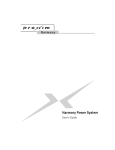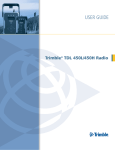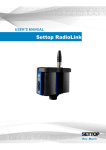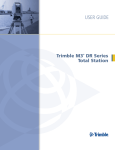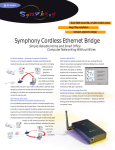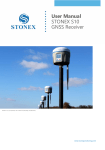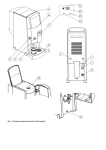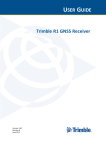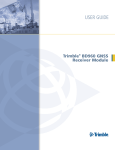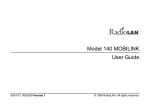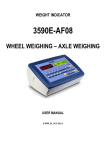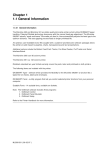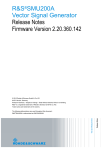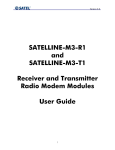Download ADL Vantage/ ADL Vantage Pro
Transcript
ADL Vantage/ ADL Vantage Pro User Guide Contact Information Warranty limitations Customer support and sales contacts This warranty set forth above is exclusive and no other warranty, whether written or oral, is expressed or implied. Pacific Crest specifically disclaims the implied warranties of merchantability and fitness for a particular purpose. Quality, technology, and service are the hallmarks of Pacific Crest. We provide easy access to our customer service department to keep you running efficiently. Headquarters Pacific Crest 510 DeGuigne Drive Sunnyvale, CA 94085 U.S.A EMEA Office HAL Trade Center Bevelandseweg 150 1703 AX Heerhugowaard The Netherlands Tel: +31-725-724-408 Tel: 1-800-795-1001 (U.S.A toll free) Fax: +31-725-348-288 +1-408 481-8070 (outside the U.S.A) Fax: +1-408 481-8984 Sales email: [email protected] Support email: [email protected] Repair info: [email protected] Web www.PacificCrest.com Support hours are 8 am to 5 pm Pacific Time. Please visit our website for up-to-date news and product announcements. Firmware and software upgrades are available from our website, usually free of charge. Legal notices ©2011 Pacific Crest. All rights reserved. Adaptation, or translation of this manual is prohibited without prior written permission of Pacific Crest, except as allowed under the copyright laws. This document contains proprietary information that is protected by copyright. All rights reserved. The information contained in this document is subject to change without notice. Trimble is a trademark of Trimble Navigation Limited, registered in the United States and in other countries. TRIMMARK and TRIMTALK are trademarks of Trimble Navigation Limited. Microsoft, Windows, and Windows Vista are either registered trademarks or trademarks of Microsoft Corporation in the United States and/or other countries. All trademarks are the property of their respective owners. Warranty PACIFIC CREST MAKES NO WARRANTY OF ANY KIND WITH REGARD TO THIS MATERIAL, INCLUDING, BUT NOT LIMITED TO, THE IMPLIED WARRANTIES OF MERCHANTABILITY AND FITNESS FOR A PARTICULAR PURPOSE. Pacific Crest shall not be liable for errors contained herein or for incidental consequential damages in connection with the furnishing, performance, or use of this material. Warranty One-Year limited warranty This warranty gives you specific legal rights. You may also have other rights which vary from state to state or area to area. Pacific Crest warrants ADL family products, inclusive of cables and batteries, against defects in materials and workmanship for a period of one year from receipt by the end-user. Exclusions Should Pacific Crest be unable to repair or replace the product within a reasonable amount of time, a refund of the purchase price may be given upon return of the product. The warranty on your radio shall not apply to defects resulting from: • Improper or inadequate maintenance by the customer • Unauthorized modification, negligence, or misuse • Operation outside of the environment specifications 1 Notices Class B Statement – Notice to Users. This equipment has been tested and found to comply with the limits for a Class B digital device, pursuant to Part 15 of the FCC rules. These limits are designed to provide reasonable protection against harmful interference in a residential installation. This equipment generates, uses, and can radiate radio frequency energy and, if not installed and used in accordance with the instructions, may cause harmful interference to radio communication. However, there is no guarantee that interference will not occur in a particular installation. If this equipment does cause harmful interference to radio or television reception, which can be determined by turning the equipment off and on, the user is encouraged to try to correct the interference by one or more of the following measures: • Reorient or relocate the receiving antenna. • Increase the separation between the equipment and the receiver. • Connect the equipment into an outlet on a circuit different from that to which the receiver is connected. • Consult the dealer or Pacific Crest directly for help. Changes and modifications not expressly approved by the manufacturer or registrant of this equipment can void your authority to operate this equipment under Federal Communications Commission rules. Canada This digital apparatus does not exceed the Class B limits for radio noise emissions from digital apparatus as set out in the radio interference regulations of the Canadian Department of Communications. Le présent appareil numérique n’émet pas de bruits radioélectriques dépassant les limites applicables aux appareils numériques de Classe B prescrites dans le règlement sur le brouillage radioélectrique édicté par le ministère des Communications du Canada. Europe This product has been tested and found to comply with the requirements for a Class B device pursuant to European Council Directive 1999/5/ EC on R&TTE, thereby satisfying the requirements for CE Marking and sale within the European Economic Area (EEA). These requirements are designed to provide reasonable protection against harmful interference when the equipment is operated in a residential or commercial environment, and to ensure that the equipment is safe. Australia and New Zealand This product conforms with the regulatory requirements of the Australian Communications and Media Authority (ACMA) EMC framework, thus satisfying the requirements for C-Tick Marking and sale within Australia and New Zealand. Notice to Our European Union Customers For product recycling instructions and more information, please go to www.trimble.com/ev.shtml. Recycling in Europe: To recycle Trimble WEEE (Waste Electrical and Electronic Equipment, products that run on electrical power.), Call +31 497 53 24 30, and ask for the “WEEE Associate”. Or, mail a request for recycling instructions to: Trimble Europe BV c/o Menlo Worldwide Logistics Meerheide 45 5521 DZ Eersel, NL ADL Vantage/ADL Vantage Pro User Guide Safety Information Before you use your radio, ensure that you have read and understood this publication, as well as safety requirements. CAUTION – A license is required before operating radio communication equipment. Warnings and cautions An absence of specific alerts does not mean that there are no safety risks involved. Always follow the instructions that accompany a Warning or Caution. The information they provide is intended to minimize the risk of personal injury and/or damage to the equipment. In particular, observe safety instructions that are presented in the following formats: WARNING – A Warning alerts you to a likely risk of serious injury to your person and/ or damage to the equipment. A warning identifies the nature of the risk and the extent of possible injury and/or damage. It also describes how to protect yourself and/or the equipment from this risk. Warnings that appear in the text are repeated at the front of the manual. CAUTION – A Caution alerts you to a possible risk of damage to the equipment and/or loss of data. A Caution describes how to protect the equipment and/or data from this Exposure to radio frequency energy The radio is designed to comply with the following national and international standards and guidelines regarding exposure of human beings to radio frequency electromagnetic energy, in addition to protection against harmful interference of neighboring electrical equipment: • • • • • • • • • • • • • • 2 FCC Report and Order FCC 96-326 (August, 1996) American National Standards Institute (C95.3-1992) National Council on Radiation Protection and Measurement (NCRP - 1986) International Commission on Non-ionizing Radiation Protection (ICNRP - 1986) European Committee for Electrotechnical Standardization (CENELEC) FCC CFR47 Part 15 FCC CFR47 Part 90 Industry Canada RSS 119 ETSI EN 300 113-2 ETSI EN 300 489 ACA AS/NZS 4295 iDA Spec 111 OFTA STD-1E RRC CMII ADL Vantage/ADL Vantage Pro User Guide Contact your sales representative for model specific country approval. To assure optimal radio performance and to ensure that exposure to RF energy is within the guidelines in the above standards, observe the following operating procedures: • Do not operate a transceiver when someone is within the distance noted below of the antenna (unity gain). – 120 cm (approximately 4 ft) for the ADL Vantage Pro radio @ 35 W – 30 cm (approximately 12 in) for the ADL Vantage/Vantage Pro radios @ 2 W – 60 cm (approximately 2 ft) for ADL Vantage/Vantage Pro radio @ 4 W – 15 cm (approximately 6 in) for the ADL Vantage radio @ 1 W • Do not operate the transceiver unless all RF connectors are secure and any open connectors are properly terminated. • Avoid contact with the antenna while operating the transceiver. • Do not operate the transceiver with a damaged antenna. If a damaged antenna comes in contact with the skin, a minor burn may result. • Do not operate the equipment near electrical blasting caps or in an explosive atmosphere. CAUTION – Changes or modifications not expressly approved by the FCC could void the user’s authority to operate the equipment. Exposure to hot surfaces The ADL Vantage Pro enclosure and heat sink may become very hot during operation, depending on the air temperature, transmit power, and transmission duty cycle. Turn off the unit and let it cool before handling. Always use the heat-resistant handle to hold or move the ADL Vantage Pro radio. Rechargeable batteries The radio uses a 12 V, deep-discharge, lead-acid battery (portable power battery). CAUTION – Storing batteries for an extended time in a discharged state damages them. Note – For specific safety information, refer to the documentation included with your battery. WARNING – Do not damage the battery. A damaged battery can cause an explosion or fire, and can result in personal injury and/or property damage. To prevent injury or damage: • • • • • • Do not use or charge the battery if it appears to be damaged. Signs of damage include, but are not limited to, discoloration, warping, and leaking battery fluid. Do not expose the battery to fire, high temperature, or direct sunlight. Do not immerse the battery in water. Do not use or store the battery inside a vehicle during hot weather. Do not drop or puncture the battery. Do not open the battery or short-circuit its contacts. WARNING – Avoid contact with the battery if it appears to be leaking. Battery fluid is corrosive, and contact with it can result in personal injury and/or property damage. To 3 ADL Vantage/ADL Vantage Pro User Guide prevent injury or damage: • • • If the battery leaks, avoid contact with the battery fluid. If battery fluid gets into your eyes, immediately rinse your eyes with clean water and seek medical attention. Do not rub your eyes! If battery fluid gets onto your skin or clothing, immediately use clean water to wash off the battery fluid. WARNING – Charge and use the rechargeable battery only in strict accordance with the instructions. Charging or using the battery in unauthorized equipment can cause an explosion or fire, and can result in personal injury and/or equipment damage. To prevent injury or damage: • • • • • Do not charge or use the battery if it appears to be damaged or leaking. Charge the battery only in a Trimble product that is specified to charge it. Ensure that you follow all instructions that are provided with the battery charger. Discontinue charging a battery that gives off extreme heat or a burning odor. Use the battery only in Trimble equipment that is specified to use it. Use the battery only for its intended use and according to the instructions in the product documentation. CAUTION – Do not use any battery charger as a power supply for any radio. This may damage the radio. Do not recharge any battery while it is connected to a radio. FCC Rules and Regulations Licensing requirements It is the responsibility of the owner to comply with applicable rules and regulations concerning the operation of a radio transmitter. In the United States, the FCC regulates the licensing of this equipment. Application for a license is made by submitting FCC Form 600 along with evidence of frequency coordination (if required) and applicable fees. Similar licensing requirements exist worldwide. Penalties for broadcasting without a license can be severe, and may include the confiscation of your radio. For more information, contact our customer service department. WARNING: Always obey local licensing requirements and restrictions. It is illegal to transmit in the United States while CSMA is turned off. CSMA is not required within the European Union and should be turned off. Equipment compliances The radios have been tested and found to comply with Parts 15 and 90 of Title 47 of the Code of Federal Regulations. They have also been tested and found compliant for type certification and approval in many other countries worldwide. For more information concerning our worldwide compliances, contact customer support. Being part of the RF community Operation of a licensed radio product makes you a member of the RF community. Be aware that virtually all frequencies licensed are provided on a shared basis with 4 ADL Vantage/ADL Vantage Pro User Guide other users. Each frequency dedicated specifically to RTK surveying activities has certain restrictions and limitations. For complete information, refer to the appropriate documentation from the licensing agency in your country of operation, e.g., Part 90, Title 47, of the Code of Federal Regulations. Most frequencies sharing data transmissions and voice transmissions give priority to voice users. Be mindful of the persistent nature of a GPS RTK data transmission and always limit your RF transmission output power when performing close-in survey situations to avoid interference with co-channel users. Pacific Crest recommends using the low RF power setting for construction site and other line-of-site surveys with baselines less than two miles (depending on terrain). WARNING: If you are in conflict with a co-channel user, select another frequency to avoid formal actions by government agencies. In most cases, you are required to vacate a frequency upon complaint by a shared channel voice user. Most survey operations are itinerant in that the system is moved on a frequent basis. For fixed system installations, you should not use frequencies set aside for itinerant operations, but should coordinate a frequency based on the fixed area operation. Regulations differ from country to country, please be aware of the local regulations before using radio equipment. Automatic station identification For operation in the United States, the FCC requires that radio transmitters broadcast a station identifier every 15 minutes. The station identifier is the call sign assigned to you on the station license. The radios support the broadcast of station identification in a manner that meets the requirements of the FCC. Upon receipt of equipment, use the ADLCONF software to program your FCC call sign into the configuration of the radio. This is only required for transmitters. The call sign is transmitted every 15 minutes in Morse code. It is not included in any data packet and so is not processed by the receiving radio. However, data transmission is interrupted for a few seconds while the call sign is being transmitted. If you leave the Call sign field blank (on the ADLCONF’s Identification screen), the radio programmed with this configuration file will not transmit any call sign. WARNING: Failure to transmit your station identification is in violation of FCC regulations. If you are operating outside the United States, check with the local authorities if you need to transmit a call sign. 5 ADL Vantage/ADL Vantage Pro User Guide Carrier Sense Multiple Access (CSMA) CSMA is a technology implemented in the radios to meet the United States Federal Communication Commission (FCC) transmitter requirements. It is illegal to transmit on any UHF radio within the United States without CSMA enabled. CSMA holds off the radio transmission if the frequency is currently being used by a co-channel user. On occasion, you may note that the radio broadcasts stop for short periods of time. Most often, this is a case of co-channel interference and the radio is holding off broadcasts due to the FCC-mandated CSMA. Note – You should turn CSMA off when transmitting within the European Union. GPS RTK equipment is designed to function with intermittent gaps in the data. Heavy co-channel use may limit the ability of the radio to transmit the required information. In areas of heavy co-channel usage, try changing channels to a less used frequency. 6 ADL Vantage/ADL Vantage Pro User Guide Contents Safety Information. . . . . . . . . . . . . . . . . . . . . . . . . . . . . . . . . . . . . . . . . . . . . . . . . . . . . . . . . . . . . . 2 Contents . . . . . . . . . . . . . . . . . . . . . . . . . . . . . . . . . . . . . . . . . . . . . . . . . . . . . . . . . . . . . . . . . . . . . . 7 Introduction . . . . . . . . . . . . . . . . . . . . . . . . . . . . . . . . . . . . . . . . . . . . . . . . . . . . . . . . . . . . . . . . . . . 8 Note about this guide . . . . . . . . . . . . . . . . . . . . . . . . . . . . . . . . . . . . . . . . . . . . . . . . . . . . . . . . . . . . . . . . . . . . . . . . . . . . . . . . . . . . 8 Technical Support. . . . . . . . . . . . . . . . . . . . . . . . . . . . . . . . . . . . . . . . . . . . . . . . . . . . . . . . . . . . . . . . . . . . . . . . . . . . . . . . . . . . . . . . 8 Your Comments. . . . . . . . . . . . . . . . . . . . . . . . . . . . . . . . . . . . . . . . . . . . . . . . . . . . . . . . . . . . . . . . . . . . . . . . . . . . . . . . . . . . . . . . . . 8 Overview . . . . . . . . . . . . . . . . . . . . . . . . . . . . . . . . . . . . . . . . . . . . . . . . . . . . . . . . . . . . . . . . . . . . . 9 Features. . . . . . . . . . . . . . . . . . . . . . . . . . . . . . . . . . . . . . . . . . . . . . . . . . . . . . . . . . . . . . . . . . . . . . . . . . . . . . . . . . . . . . . . . . . . . . . . . . 9 Compatibility . . . . . . . . . . . . . . . . . . . . . . . . . . . . . . . . . . . . . . . . . . . . . . . . . . . . . . . . . . . . . . . . . . . . . . . . . . . . . . . . . . . . . . . . 9 Enhanced user interface. . . . . . . . . . . . . . . . . . . . . . . . . . . . . . . . . . . . . . . . . . . . . . . . . . . . . . . . . . . . . . . . . . . . . . . . . . . . . . 9 Fast over-the-air data rate . . . . . . . . . . . . . . . . . . . . . . . . . . . . . . . . . . . . . . . . . . . . . . . . . . . . . . . . . . . . . . . . . . . . . . . . . . . . 9 User-selectable RF output . . . . . . . . . . . . . . . . . . . . . . . . . . . . . . . . . . . . . . . . . . . . . . . . . . . . . . . . . . . . . . . . . . . . . . . . . . . . 9 Rugged construction . . . . . . . . . . . . . . . . . . . . . . . . . . . . . . . . . . . . . . . . . . . . . . . . . . . . . . . . . . . . . . . . . . . . . . . . . . . . . . . . . 9 Software compatibility . . . . . . . . . . . . . . . . . . . . . . . . . . . . . . . . . . . . . . . . . . . . . . . . . . . . . . . . . . . . . . . . . . . . . . . . . . . . . . . 9 Configuring the Radios . . . . . . . . . . . . . . . . . . . . . . . . . . . . . . . . . . . . . . . . . . . . . . . . . . . . . . . . . 10 ADLCONF configuration software . . . . . . . . . . . . . . . . . . . . . . . . . . . . . . . . . . . . . . . . . . . . . . . . . . . . . . . . . . . . . . . . . . . . . . .10 Factory default settings. . . . . . . . . . . . . . . . . . . . . . . . . . . . . . . . . . . . . . . . . . . . . . . . . . . . . . . . . . . . . . . . . . . . . . . . . . . . . . . . . .10 Setup in the Office. . . . . . . . . . . . . . . . . . . . . . . . . . . . . . . . . . . . . . . . . . . . . . . . . . . . . . . . . . . . . . . . . . . . . . . . . . . . . . . . . . . . . . .11 Setting up in the Field . . . . . . . . . . . . . . . . . . . . . . . . . . . . . . . . . . . . . . . . . . . . . . . . . . . . . . . . . . . . . . . . . . . . . . . . . . . . . . . . . . .12 Tripod mounts . . . . . . . . . . . . . . . . . . . . . . . . . . . . . . . . . . . . . . . . . . . . . . . . . . . . . . . . . . . . . . . . . . . . . . . . . . . . . . . . . . . . . .13 Antenna and antenna mount . . . . . . . . . . . . . . . . . . . . . . . . . . . . . . . . . . . . . . . . . . . . . . . . . . . . . . . . . . . . . . . . . . . . . . . .13 Data/Power cable . . . . . . . . . . . . . . . . . . . . . . . . . . . . . . . . . . . . . . . . . . . . . . . . . . . . . . . . . . . . . . . . . . . . . . . . . . . . . . . . . . .14 Indicator LEDs . . . . . . . . . . . . . . . . . . . . . . . . . . . . . . . . . . . . . . . . . . . . . . . . . . . . . . . . . . . . . . . . . . . . . . . . . . . . . . . . . . . . . .14 Enclosure . . . . . . . . . . . . . . . . . . . . . . . . . . . . . . . . . . . . . . . . . . . . . . . . . . . . . . . . . . . . . . . . . . . . . . . . . . . . . . . . . . . . . . . . . . .14 Antenna connector. . . . . . . . . . . . . . . . . . . . . . . . . . . . . . . . . . . . . . . . . . . . . . . . . . . . . . . . . . . . . . . . . . . . . . . . . . . . . . . . . .15 Battery care . . . . . . . . . . . . . . . . . . . . . . . . . . . . . . . . . . . . . . . . . . . . . . . . . . . . . . . . . . . . . . . . . . . . . . . . . . . . . . . . . . . . . . . . . . . . .15 Charging . . . . . . . . . . . . . . . . . . . . . . . . . . . . . . . . . . . . . . . . . . . . . . . . . . . . . . . . . . . . . . . . . . . . . . . . . . . . . . . . . . . . . . . . . . . .15 Operating the Radio . . . . . . . . . . . . . . . . . . . . . . . . . . . . . . . . . . . . . . . . . . . . . . . . . . . . . . . . . . . 17 Turning the radio on and off . . . . . . . . . . . . . . . . . . . . . . . . . . . . . . . . . . . . . . . . . . . . . . . . . . . . . . . . . . . . . . . . . . . . . . . . . . . . .17 User interface . . . . . . . . . . . . . . . . . . . . . . . . . . . . . . . . . . . . . . . . . . . . . . . . . . . . . . . . . . . . . . . . . . . . . . . . . . . . . . . . . . . . . . . . . . .17 CSMA. . . . . . . . . . . . . . . . . . . . . . . . . . . . . . . . . . . . . . . . . . . . . . . . . . . . . . . . . . . . . . . . . . . . . . . . . . . . . . . . . . . . . . . . . . . . . . . . . . .21 Security code. . . . . . . . . . . . . . . . . . . . . . . . . . . . . . . . . . . . . . . . . . . . . . . . . . . . . . . . . . . . . . . . . . . . . . . . . . . . . . . . . . . . . . . . . . . .21 Edit configuration . . . . . . . . . . . . . . . . . . . . . . . . . . . . . . . . . . . . . . . . . . . . . . . . . . . . . . . . . . . . . . . . . . . . . . . . . . . . . . . . . . . . . . .21 Scrambling. . . . . . . . . . . . . . . . . . . . . . . . . . . . . . . . . . . . . . . . . . . . . . . . . . . . . . . . . . . . . . . . . . . . . . . . . . . . . . . . . . . . . . . . . . . . . .22 Forward Error Correction . . . . . . . . . . . . . . . . . . . . . . . . . . . . . . . . . . . . . . . . . . . . . . . . . . . . . . . . . . . . . . . . . . . . . . . . . . . . . . .22 Previous Error. . . . . . . . . . . . . . . . . . . . . . . . . . . . . . . . . . . . . . . . . . . . . . . . . . . . . . . . . . . . . . . . . . . . . . . . . . . . . . . . . . . . . . . . . . .22 Automatic Power Management. . . . . . . . . . . . . . . . . . . . . . . . . . . . . . . . . . . . . . . . . . . . . . . . . . . . . . . . . . . . . . . . . . . . . . . . . .23 Tips and Techniques for Best Performance. . . . . . . . . . . . . . . . . . . . . . . . . . . . . . . . . . . . . . . . . . 24 Antenna . . . . . . . . . . . . . . . . . . . . . . . . . . . . . . . . . . . . . . . . . . . . . . . . . . . . . . . . . . . . . . . . . . . . . . . . . . . . . . . . . . . . . . . . . . . . . . . .24 Line loss . . . . . . . . . . . . . . . . . . . . . . . . . . . . . . . . . . . . . . . . . . . . . . . . . . . . . . . . . . . . . . . . . . . . . . . . . . . . . . . . . . . . . . . . . . . . . . . .24 Power supplies . . . . . . . . . . . . . . . . . . . . . . . . . . . . . . . . . . . . . . . . . . . . . . . . . . . . . . . . . . . . . . . . . . . . . . . . . . . . . . . . . . . . . . . . . .24 Equipment care . . . . . . . . . . . . . . . . . . . . . . . . . . . . . . . . . . . . . . . . . . . . . . . . . . . . . . . . . . . . . . . . . . . . . . . . . . . . . . . . . . . . . . . . .24 Use with Machinery and Vehicles . . . . . . . . . . . . . . . . . . . . . . . . . . . . . . . . . . . . . . . . . . . . . . . . . 25 Vibration damping . . . . . . . . . . . . . . . . . . . . . . . . . . . . . . . . . . . . . . . . . . . . . . . . . . . . . . . . . . . . . . . . . . . . . . . . . . . . . . . . . . . . . .25 Mounting inside/outside vehicle cabin. . . . . . . . . . . . . . . . . . . . . . . . . . . . . . . . . . . . . . . . . . . . . . . . . . . . . . . . . . . . . . . . . . .25 DC power supply with power conditioner . . . . . . . . . . . . . . . . . . . . . . . . . . . . . . . . . . . . . . . . . . . . . . . . . . . . . . . . . . . . . . .25 Protection from electromagnetic interference . . . . . . . . . . . . . . . . . . . . . . . . . . . . . . . . . . . . . . . . . . . . . . . . . . . . . . . . . . .25 Pinouts and Connectors . . . . . . . . . . . . . . . . . . . . . . . . . . . . . . . . . . . . . . . . . . . . . . . . . . . . . . . . . 26 Antenna . . . . . . . . . . . . . . . . . . . . . . . . . . . . . . . . . . . . . . . . . . . . . . . . . . . . . . . . . . . . . . . . . . . . . . . . . . . . . . . . . . . . . . . . . . . . . . . .26 Connector manufacturer contacts . . . . . . . . . . . . . . . . . . . . . . . . . . . . . . . . . . . . . . . . . . . . . . . . . . . . . . . . . . . . . . . . . . .26 Technical Specifications . . . . . . . . . . . . . . . . . . . . . . . . . . . . . . . . . . . . . . . . . . . . . . . . . . . . . . . . . 27 7 ADL Vantage/ADL Vantage Pro User Guide Introduction This manual describes how to set up and use the Advanced Data Link (ADL) Vantage™ or Vantage Pro radio. The radios are advanced, high speed, wireless data links that are designed specifically for GNSS/RTK applications, but are also appropriate for many other applications requiring digital data links. Your success in using the radios is Pacific Crest’s primary goal. Pacific Crest stands behind its products by providing expert support and service. Your comments and questions are welcome. This guide provides information concerning the use of the following radios: • ADL Vantage Model numbers ADLV-1 (390 to 430 MHz) and ADLV-2 (430 to 473 MHz) • ADL Vantage Pro Model numbers ADLP-1 (390 to 430 MHz) and ADLP-2 (430 to 473 MHz) This guide is written for the first-time user and gives details concerning system setup, operation, and maintenance. We urge you to take the time to review this short manual completely before you set up the system. Note about this guide We believe that the ADL Vantage/Vantage Pro systems provides the best value and performance for the user. As such, we provide our equipment in complete turnkey systems, including all of the items necessary for operation with your GPS. You may have purchased this radio from a third-party supplier. On occasion, the bundled product provided by these sources may differ from the kits provided directly from Pacific Crest. If this guide does not accurately reflect the equipment that you received, please contact your supplier for specific instructions concerning the setup of items that differ. Technical Support If you have a problem and cannot find the information you need in the product documentation, contact your local dealer or go to the Support area of the Pacific Crest website (www.pacificcrest.com/support.php). Product updates, documentation, and any support issues are available for download. If you need to contact technical support, email [email protected]. Your Comments Your feedback about the supporting documentation helps us to improve it with each revision. Email your comments to [email protected]. 8 ADL Vantage/ADL Vantage Pro User Guide Overview Features Compatibility • Facilitates radio equipment mix and match • Interoperable with Pacific Crest (RFM, PDL, and ADL), SATEL®, and Trimble® radio products • All models support 12.5 kHz and 25 kHz channel bandwidth communications • 40 MHz-wide channel tables (390 MHz–430 MHz and 430 MHz–473 MHz models) • Provides upgrade path for existing installations Enhanced user interface • Backlit LCD display and five-button navigation interface • View and change radio channel, modulation, and protocol types • Monitor signal levels, baud rates, and other parameters Fast over-the-air data rate • 19,200 bits per second • Reduced latency provides better GNSS position information • Shorter transmit times reduces power consumption for longer battery life User-selectable RF output ADL Vantage: Select between 0.1 W, 0.5 W, 1 W, 2 W, and 4 W ADL Vantage Pro: Select between low power (2 W), medium power, and high power (as high as 35 W) • Increase range by switching to a higher output power • Increase battery life by reducing output power when you do not need the range Rugged construction Designed specifically for real-world working environments • All metal construction and shock-mounted electronics ensure highest reliability and EMI-resistance. • Watertight, corrosion-resistant connectors stand up to bad weather conditions. Software compatibility Current versions of the following software were tested and verified for compatibility with Windows® 7, Windows XP, and the Business Edition of the Windows Vista® operating systems: • ADLCONF • PCC Range Estimator 9 ADL Vantage/ADL Vantage Pro User Guide Configuring the Radios ADLCONF configuration software ADLCONF is the software application for configuring and troubleshooting all Advanced Data Link (ADL) radios. Running the ADLCONF software on a computer attached through a serial cable to an ADL radio enables you to check the status of the radio, enter receive-only channel tables, and set radio parameters such as channel bandwidth and output power. Channel tables for transmission of data must be obtained from authorized Pacific Crest dealers. If your radio did not come with a channel table already installed, you can obtain one from your dealer and then import it using the ADLCONF software. The latest version is available for free download from www.PacificCrest.com. The ADLCONF User Guide is also available on the Pacific Crest website. A user guide that describes how to configure the ADL Vantage radio is available by running the ADLCONF software and then selecting Help / User Guide. Factory default settings To return the radio to its factory default configuration, use the ADLCONF software. Click Restore Factory to the right of the screen and then click Program. The following table shows the factory default settings: 10 Description Default Setting Device Status Battery status Chanel/Frequency Channel 01 and frequency (MHz) Channel Tx Frequency Channel No. and frequency (MHz) Data Protocol Transparent EOT (End of Transmission) Radio Link Rate 9600 Operation Mode (Trimble protocol) Base/Rover Sensitivity High (Rover) Rx LED Meaning Signal Received Serial Baud 38000 Advanced Menus Hide CSMA On Security Code Off Edit Configuration Enabled Scrambling On Forward Error Correction On Language Select (ADL Vantage Pro only) English ADL Vantage/ADL Vantage Pro User Guide Setup in the Office 1. 2. 3. 4. 5. 6. 7. 11 Plug the radio’s desktop power supply into the wall. You may alternatively use an approved 12 Volt battery for power. But you must never power a radio with a battery while it is being recharged. This will damage the battery. Attach the desktop power supply’s (or battery’s) SAE connector to the radio programming cable’s SAE connector. Attach the programming cable’s DE-9 connector into a serial port on your PC. If your PC does not have a serial port, you should use a serial-to-USB adaptor. Attach the programming cable’s LEMO plug (with the red dot facing up) into the bottom of the radio. This will turn the radio on. Install ADLCONF, available for free download from http://www.pacificcrest.com/support. php?page=updates. Launch ADLCONF and refer to its user guide for instructions on connecting to ADL radios. The user guide is displayed when you click Help > User Guide on ADLCONF’s main menu. In most cases, you simply click the Connect button on the right of the ADLCONF main screen. After connecting to the radio for the first time you should click File > Export and save a copy of the radio’s original configuration to your PC. You also can return the radio to its factory configuration by clicking File > Import and selecting this file. You will not lose any channel tables or personalized configurations such as Owner Name or Call Sign by importing a configuration file. ADL Vantage/ADL Vantage Pro User Guide Setting up in the Field 1. 2. 3. 4. 5. Attach the antenna to the radio, either directly to the top of the radio or to an antenna cable. Attach the radio to your tripod using the tripod clip on the back of the radio. See the figure be low for setup suggestions. Connect the radio to the source of the data you will transmit, for example, a GPS receiver, using the data/power cable. The ADL Vantage and ADL Vantage Pro radios use the same data connector – with the same pinouts - found on the PDL HPB radio. This makes the radios compatible with existing HPB data cables. Join the data/power cable’s SAE connector to the 12 Volt battery’s SAE connector. This will turn the radio on. If the radio had previously been powered on and then off, turn it on again by pressing the On/Off button in the center of the front panel. The ADL Vantage’s and ADL Vantage Pro’s user interface allows you to configure and trouble shoot your radio in the field. The top row of the radio’s LCD displays the name of the currently selected firmware function. Press the right or left buttons on the front panel to display other functions available in the ADL Vantage. The bottom row displays the various options for the selected function. The currently active setting is marked with an asterisk. To select another option for the displayed function, press the up or down button to display the desired parameter. Then press Enter to reconfigure the radio to use this new parameter. Note – If you operate the ADL Vantage Pro in a fixed installation, you should attach it to a wall with the wall mount accessory (P/N 84269). The wall mount includes two small fans that move air over the rear of the radio to reduce its internal temperature when transmitting at high duty cycle. 12 ADL Vantage/ADL Vantage Pro User Guide Tripod mounts Each ADL Vantage radio includes a tripod clip on the rear of the radio. Insert the clip into a slot on the tripod: Each ADL Vantage Pro radio includes a high-impact polymer handle with built-in tripod clip. Insert the clip into a slot on the tripod: Antenna and antenna mount If you have an antenna with a male TNC connector, you can attach it directly to the RF connector on the top of the radio. We highly recommend, however, that you elevate the RF antenna as much as possible. The most common set up is similar to that shown in the following illustration where an antenna cable with male TNC connector is attached to the radio. The other end of this cable is attached to a tripod or elevated section of range pole. The RF antenna is then attached to the end of the cable. Pacific Crest offers an antenna cable that attaches to standard 5/8-in threaded tripods and range poles and antennas with NMO connectors. Inspect the antenna center push-pin contact to ensure that it makes good contact with the antenna mount. A good antenna connection is critical to system performance. Note – Always ensure that an antenna is connected before transmitting with any radio. A good field practice is to attach the antenna before you turn on the radio and then turn off the radio before you detach the antenna. Using a gained antenna raises the Effective Isotropic Radiated Power (EIRP) of the radio. Ensure that the resultant EIRP does not exceed your licensed limit. 13 ADL Vantage/ADL Vantage Pro User Guide Data/Power cable The radio is connected to a data source, such as a GNSS receiver, using a data/power cable (see below). This cable is available with different connectors for attaching to a large variety of data sources. Contact your sales representative for selecting the best cable to meet your needs: Data Source Connector Radio Connector SAE Power Connector Each radio data/power cable also connects the radio (and in some cases, the data source) to external power through an SAE-type connector. Pacific Crest strongly recommends you use the external battery, which includes an SAE connector. It is sold both separately and as part of the battery/charger kits. Indicator LEDs LED Description Tx Shows that the radio is broadcasting. In most GPS RTK applications, the Tx LED flashes approximately once per second. Pwr Shows the power status and also provides a high and low external voltage supply indicator. When lit, power is turned on. If the power is too high or too low, the LEDs will flash the number of the Error Code (see page 22). The PWR LED blinks when the external voltage drops to a level determined using ADLCONF software. (The default level is 10 VDC.) If the PWR LED does not turn on/off when pressing the On/Off button on the radio’s front panel, inspect the external voltage supply. The minimum voltage required by the radio is 9 VDC. Rx Shows that the radio is receiving signals from another radio or from a source of interference. The default is Signal received, but you can reset the radio so that when its Rx LED flashes it means Data packets received. You can reset the meaning either through the radio or with the ADLCONF software. During normal operation, the Rx LED flashes at once per second to show reception of transmissions from the transmitting radio. If the Rx LED is on continuously, a source of interference may be affecting the radio’s ability to receive data. To reduce or eliminate the interference, reposition the antenna, or change to another channel at both the transmitter and receiver. Enclosure The radio enclosure is made from a tough, impact-resistant aluminum alloy. The enclosure receives an anti-corrosion treatment and is further protected with a chemicaland scratch-resistant polyurethane coating. Elastomer end caps provide the first level of 14 ADL Vantage/ADL Vantage Pro User Guide shock protection for the internal components. An internal isolation system reduces the effects of vibration on the radio receiver board. Antenna connector The integrated antenna connector provides an industry standard TNC-female RF connector that is compatible with a wide range of mobile whip antennas. Pacific Crest also sells cables that connect the radio to remote antennas. Battery care The ADL Vantage Battery/Charger kit includes a 12 V, 12-AHr, battery. The ADL Vantage Pro Battery/Charger kit includes a 12 V, 35-AHr, battery. Both are deep-cycle, deep-discharge, sealed lead-acid batteries, also known as portable power batteries. Both batteries provide all-day operation for the respective radios and can be recharged approximately 300 times over a period of three years if proper care is maintained. A deep-discharge battery will last longer if it is never fully discharged during use and always fully charged before storage. If the battery is discharged entirely, the capacity will diminish. The ADL Vantage Pro radio will maintain the transmit power level as the battery voltage is reduced. Transmitting at a high power level for a long period of time may cause the battery to reach the automatic shut off level before eight hours of use and will need to be recharged. If you use your own battery, select a deep-discharge battery with a minimum capacity of 30 AHr. If necessary, you can use an automotive battery, but it will be damaged by repetitive discharge/charge cycles. An automotive battery will lose capacity in just a few cycles. Pacific Crest does not recommend this practice. To protect the battery from over-discharge, an ADL Vantage or ADL Vantage Pro will flash a low voltage warning when the input voltage declines to 10 V DC. If the voltage continues to decline, the radio will shut itself off at 9 V DC. At 10 V DC, the LEDs on the front of the radio will flash twice, pause, flash twice again, pause, etc. indicating low input voltage. If a radio has shut itself off because of low input voltage, it will automatically turn itself back on when the voltage returns to 9 V DC or higher. The 10 V warning and 9 V shut-off levels are the factory defaults. If you wish, you can use ADLCONF software (Radio Link - Advanced screen) to configure other power levels. The minimum shut off level for an ADL Vantage Pro is 9 V DC and cannot be changed. You can input a lower value for the ADL Vantage, but please be advised that values lower than 9 V might permanently damage your battery. Charging The charger supplied with the radio Battery/Charger kit provides two-stage charging and must be connected to the battery following every full day of operation to ensure good battery life and performance. The first stage quickly charges the battery to capacity, and the second stage trickle charges the battery to maintain a full charge. It is important to recharge your battery every time it is used. Do not allow a battery to remain in a discharged state any longer than necessary. 15 ADL Vantage/ADL Vantage Pro User Guide It is important to periodically charge any battery that is stored for an extended length of time. Storing batteries for an extended time in a discharged state damages them and will reduce the capacity of the battery. To recharge a user-supplied battery, select a charger of appropriate type. A battery charge designed for use with a deep-cycle, deep-discharge, sealed lead acid battery may damage an automotive battery. An automotive battery charger may not fully charge a deep-cycle, deed-discharge, sealed lead acid battery. Never recharge any battery while it is connected to a radio as it could damage the radio and/or the battery. 16 ADL Vantage/ADL Vantage Pro User Guide Operating the Radio Turning the radio on and off CAUTION – The ADL Vantage Pro enclosure and heat sink may become very hot during operation. The radio’s temperature depends on the ambient temperature, RF power selection, and transmission duty cycle. Turn off the unit and allow it to cool before handling. Always use the heat-resistant handle to hold or move the ADL Vantage Pro radio. To turn on the radio, attach the radio to power using either the programming cable (attached to wall/mains current) or the data/power cable (attached to the external battery of the radio). Once the radio detects power on its data connector, it automatically turns on and is ready for communication within 5 seconds. If the wall/mains current is interrupted, the radio automatically turns itself on and resumes transmitting data within 5 seconds of power restoration. If the radio is attached to an antenna when the radio is turned on, it automatically runs an antenna test before it will communicate. Wait until this test is complete before transmitting any data. To turn off the radio, either detach its power cable or depress the On/Off button in the center of the front panel for 5 seconds.. To turn the radio on again, either press the On/Off button or remove and reinsert the data/power cable. User interface The user interface includes three LEDs, an On/Off button, a two-row LCD display, four scrolling buttons marked with arrows, and a central Enter button: The LCD has a backlight that stays on for 20 seconds. The backlight must be on for the Enter or arrow buttons to function. If the backlight is off, pressing any button turns it on. To have the backlight stay on, click the Advanced button on the ADLCONF Serial 17 ADL Vantage/ADL Vantage Pro User Guide Interface screen and clear the Turn off radio LCD backlight after 20 seconds check box. Click the ADLCONF Program button to program the radio with this change. To save power, the LCD and keypad on the ADL Vantage Pro will automatically go into sleep mode 5 minutes after the last keystroke. All other features, including the transmitter and LEDs, will continue to function normally. To wake up the LCD and keypad, press the On/Off button for one second. To turn the ADL Vantage Pro off when its LCD and keypad are in sleep mode, depress the On/Off button for 5 seconds or remove the power cable. The LCD displays information that is determined in any of five different ways: • Settings such as the serial number and model number are written in the factory • The battery status, signal strength, and error codes are constantly monitored by the radio firmware • The channel tables (including frequency and bandwidth) and maximum transmit power are determined by your dealer • Everything else can be set by you using the ADLCONF software In addition, you can configure many radio settings using the buttons on the front panel and the LCD. The top rows of the LCD display the name of the currently selected radio configuration function. The bottom LCD rows display the various parameters you can choose for the displayed function. Press the left or right arrows to scroll to different functions. Press the up or down arrows to scroll to different choices for the displayed function. The following table describes the various functions available, and lists the choices for each function. The default settings, where applicable, are shown in bold. Function Description Parameter choices Device Status Displays radio status and identification Battery status information Owner name Call sign Modulation type Channel bandwidth Transmitter status Firmware version Channel / Frequency Displays/selects channel number and receive frequency Channel 01 and frequency (MHz) Channel 02 and frequency (MHz) Etc. Ch TX Frequency Displays Tx freq (if different from the channel’s Rx freq) Channel No. and frequency (MHz) Data Protocol Displays/selects data protocol type Trans EOT (End of Transmission) Trans EOC (End of Character) Packet Switched TRIMTALK™ 450S TRIMMARK™ II/IIE TT450S (HW) TRIMMARK 3 SATEL Trans FST South 18 ADL Vantage/ADL Vantage Pro User Guide Function Description Parameter choices Radio Link Rate Displays/selects bit rate for radio transmission/reception 4800 8000 9600 16000 19200 Repeater Mode Operation Mode Sets the radio to be a repeater (non-Trimble) protocols Off (Not a repeater) Sets the radio to be a repeater (Trimble protocols) Base/Rover On (Is a repeater) Basw w/ One Rpt Base w/Two Rpt Repeater 1 Repeater 2 Sensitivity Displays/selects radio squelch level High (rover) Moderate Low (base) Transmit Power Displays / selects transmitter power level Low power Low intermediate power Intermediate power High intermediate power High power Rx LED Meaning Serial Baud Displays/selects what it means when the Rx LED flashes Signal received Displays/selects serial baud rate of the radio’s data port 2400 Data received 4800 9600 19200 38400 115200 Signal Strength Displays strength of the received signal (RSSI) in dBm Press the Enter button Advanced Menus Displays or conceals rarely used menus Hide Show CSMA Displays/selects Carrier Sense Multiple Access Settings On Encrypts/Decrypts transmitted data Off (Not displayed if a Trimble protocol is selected or if no code has been programmed into the radio.) On Edit Configuration Enables/Disables configuration using the radio interface Enabled Scrambling Fills dead air with non-zero bits On (Not displayed if a Trimble protocol is selected.) Off Security Code FEC Disabled Turns Forward Error Corrections on/off On (Not displayed if a Trimble protocol is selected.) 19 Off Off ADL Vantage/ADL Vantage Pro User Guide Function Description Parameter choices TX Power Adjust Turns automatic power regulation on/ off Auto Previous Error Displays current error status No Error Language Select (ADL Vantage Pro only) Selects the display language Fixed English Chinese Russian For the field-configurable functions, the available choices are displayed on the bottom row of the LCD. The currently selected parameter is marked with an asterisk. To select a different choice for the displayed function, scroll up or down with the arrow buttons and press Enter when the required choice is displayed. There are two ways to move to a different function screen: • When viewing a display-only function, such as Device Status or Signal Strength, press the left or right arrow. • When viewing a display-and-select function, such as Channel/Freq or Data Protocol, press the up/down arrows to display the currently selected parameter (marked with an asterisk) in the second row. Then press either the left or right arrow to move to a new function screen. Note – If the currently selected parameter (shown with an asterisk) is not currently displayed on the LCD, and the backlight is off, you have not pressed a button for more than 20 seconds, you can scroll directly to the selected parameter by pressing the left or right arrow once. To move to a new function screen, press the left or right arrow a second time. To speed field configuration and to prevent the selection of unsupported radio configurations, the user interface displays only those function settings that make sense based on the settings chosen for previously displayed functions. What you choose for the data protocol determines your options for radio link rate and repeater mode. For example, if your channel table is set to 12.5 kHz channel spacing, and you select TT450S (HW) on the Data Protocol screen, you cannot select a radio link rate (the Radio Link Rate screen does not even appear) because the TT450S (HW) protocol works with 12.5 kHz channel spacing only at 4800 bps. And because TT450S (HW) is a Trimble protocol, Trimblespecific “Operation Modes” (instead of “Repeater Modes”) are available for selection. If you decide to undo any of these selections, press the left arrow to return to the Data Protocol screen and then select a different protocol. Although the radio modem supports both GMSK and 4FSK modulation, you cannot select a modulation type with the user interface. The radio automatically selects the appropriate modulation based on the channel bandwidth of the radio’s channel table (displayed on the Device Status screen as BW: 12.5 or 25 kHz), the data protocol, and the radio link rate. If you want to select a modulation type first and then an appropriate channel bandwidth, protocol and link rate, use the ADLCONF software to configure the radio. Eight rarely changed functions are grouped together under Advanced Menus. In order to speed everyday navigation, they are not displayed. The default values are indicated in the table above. To make a change to any of these functions, go to the Advanced Menus feature, press the down arrow until Show appears on the second line and then press the 20 ADL Vantage/ADL Vantage Pro User Guide Enter button. Press the right arrow sequentially to display these eight functions. To hide these features, return to the Advanced Menus feature and then select the Hide option. CSMA Carrier Sense Multiple Access (CSMA) is required only in the United States. You should turn CSMA off when transmitting within the European Union. Security code You can use the ADLCONF software to configure ADL radios to send and receive encrypted data via the Transparent EOT/EOC or Packet Switched protocols. When an ADL Vantage/Vantage Pro radio is programmed for encryption and is set to one of these three supporting protocols, the Security Code screen is displayed as one of the Advanced Menus. Only radios that are set to one of these three Pacific Crest protocols and are programmed by the ADLCONF program with this code, can interpret data sent by any similarly configured radio. The Security Code screen does not appear when the radio is set to any protocol except Transparent EOT/EOC or Packet Switched protocols or when no code was programmed into the radio using the ADLCONF software. You cannot enter a security code using the radio’s interface. To turn off the Security Code feature, press the Up or Down arrow to display the Off option and then press Enter. To turn on the security feature, select the On option. Note – With the Security Code feature on, the radio will be unable to communicate with other radios that are not set to use the same code. When you enable this feature for one radio, therefore, you should enable it for all the radios in the same communication network. ADL radios with button/LCD interfaces can turn the Security Code feature on or off in the field, but all other Pacific Crest radios must be attached to a computer running the appropriate configuration software to disable the Security Code feature. Edit configuration The LCD display includes an Edit Config screen that indicates if configuring the radio with the keypad is Enabled or Disabled. The current selection is displayed with an asterisk on the second row of the Edit Config screen. To switch the selection: 1. Press the down arrow to display the other option and then press Enter. You must enter a passcode, which is 369369 for all ADL radios. 2. Press the right arrow to display a 3 on the second row. 3. Press the down arrow to display a 6. 4. Press the left arrow to display a 9. 5. Repeat Step 2 through Step 4. When you see 369369 displayed on the second row of the LCD, press Enter; the keypad’s ability to configure the radio is changed. You can also use the ADLCONF software to enable/disable the Edit Config function in 21 ADL Vantage/ADL Vantage Pro User Guide the radio. Select/clear the Enable check box in the Advanced menu of the Serial Interface screen. Scrambling To demodulate a digital transmission, a receiver must synchronize itself with the transmitter. This can be hard to do when the transmitter sends a long series of one’s or a long series of zeroes. But if every nth character in the transmission were switched, a one to a zero or a zero to a one, and if the receiver is expecting this, it can more quickly synchronize itself with the transmission. This is essentially what Scramble Control does and why we recommend you leave it on for all radios. However, if some of the radios in your system are not Pacific Crest or Trimble radios, you may need to turn Scrambling off. Note - Trimble protocols require Scrambling. With a Trimble protocol selected, you are unable to turn scrambling off. Forward Error Correction Forward Error Correction places extra bits in the transmitted data so receivers can check for transmission errors. Although data throughput is adversely affected, using Forward Error Correction can greatly improve range and so is strongly recommended. Note – The Forward Error Correction screen does not appear when using Trimble protocols as they do not support forward error correction. Previous Error The radios perform a variety of power-up and run-time tests to ensure optimal operation. Tests include environmental as well as electrical measurements designed to avoid damage to the unit while maintaining adequate operation. In the event of an error condition, an error code is displayed on the LCD screen and the Pwr LED flashes the number of the error code (two flashes for Error Code 02, followed by a pause, two more flashes, etc.). The following table lists the possible error conditions: 22 Code Description What to do 01 Input voltage is too high 02 Input voltage is too low Check battery or power supply voltage level; check power cables; recharge or replace the battery; check the charger. 08 Internal temperature exceeds limit for operation Place the radio in the shade; check the antenna and antenna cables for damage or disconnection; set radio link rate to 19200 to reduce the duty cycle. 11 Memory error 12 RAM Error During Initialization Turn the radio off and wait a full second before turning it back on. If the radio still reports Error Code 11 or 12, the SRAM memory may be corrupted. Contact Customer Service. ADL Vantage/ADL Vantage Pro User Guide Code Description What to do 15 Transmit Frequency Lock Error 16 Receive Frequency Lock Error If you are using the radio as a repeater, ensure that the transmit and receive frequencies are less than 10 MHz apart. Otherwise, you should return the radio for service. If the radio displays Error Code 15 (Transmit frequency lock error), it is important to stop using it because the frequency control might be unstable and you might be transmitting at an unprogrammed frequency for which you are not licensed. 17 Serial buffer overflow If data comes into the radio faster than it can be transmitted, the serial buffer can overflow. If the radio displays Error Code 17, adjust the serial baud rate and radio link rate so the radio has enough time to transmit each data packet before the next packet is sent to the radio. If the radio continues to display the error code after you have fixed the situation, clear the error code from the radio’s display. Press the On/Off button for four seconds (turning off the radio), wait one full second and then press the On/Off button again. If an error warning persists, contact an authorized dealer or customer support. Automatic Power Management All ADL radios protect themselves from heat damage by shutting down if the temperature inside the radio exceeds 85°C (185°F). Keeping the ambient (air) temperature below the maximum operational temperature of 65°C (149°F) is the best way to ensure that the internal temperature of the radio does not exceed the 85°C internal limit. If an ADL radio does shut down in response to high temperature, wait until the radio cools down and then turn it back on either by pressing the On button or by removing and re-inserting the power/data cable. When the radio is turned back on after exceeding its operational temperature maximum, it displays and Error 08 (high temperature) message. To clear this message, power cycle the radio. If the storage temperature exceeds the 85°C maximum, the radio can continue to display the Error 08 and may require repair. The 35-Watt ADL Vantage Pro radio generates more heat than the 4-Watt ADL Vantage radio. For this reason, it includes an Automatic Power Management feature that reduces the transmit power before the radio’s internal temperature reaches the 85°C maximum. The ADL Vantage Pro will continue to transmit at reduced power until the internal temperature reaches 73°C (163°F), whereupon the radio will automatically restore transmit power to the original setting. If the Automatic Power Management feature is ever activated, the ADL Vantage Pro LCD will display an Error 08 (high temperature) message. Press the Enter button to clear this message and then go to the radio’s Device Status screen to display the current transmit power setting. There are many ways you can reduce the temperature of your ADL radio besides reducing the transmit power. Doubling the radio link rate halves the amount of heat generated by the radio. Using a compressed data format such as CMRx can reduce the data packet size by as much as 60% allowing the radio to generate 60% less heat. On hot days, keeping the radio above the ground and out of direct sunlight can lower the temperature as much as 20°. When installing the ADL Vantage Pro [TDL 450H] in a fixed location, you should use the wall mount with fan accessory (P/N 84269). 23 ADL Vantage/ADL Vantage Pro User Guide Tips and Techniques for Best Performance Antenna Antenna placement is critical for good performance. Range and coverage is directly proportional to the height of the transmitting and receiving antennas in addition to antenna gain. Where possible, select a reference station location that takes advantage of terrain to get the transmitting antenna as high as possible. Always use the telescoping antenna mast and raise the antenna as high as is practical and safe given terrain and wind conditions. Do not use a gained antenna if doing so increases the radio’s Effective Isotropic Radiated Power beyond the limit of your license. Line loss Line loss from connectors and cables between the radio and antenna decreases the output power transmitted by the antenna, thereby decreasing the signal’s range. To minimize line loss, please check the loss-per-length of cable to be used. For every 3 dB of line loss, the ERP (Effective Radiated Power) decreases by half. For example, if you have a 4 W radio and a line loss of 3 dB in your cable and antenna, the power effectively radiating from the antenna is 2 W. Every 6 dB of loss reduces the radio’s effective range by 50%. Power supplies Maintain batteries in a fully charged state. They last longer if they are do not become completely discharged. We recommend routinely connecting the battery to its charger after every working day and for 24 hours every three months during period of non-use. This ensures optimal performance and long battery life. Equipment care Routine equipment care prolongs the life and reliability of your radio. Radio communication equipment is susceptible to damage from shock or environmental extremes. Never operate the radio outside the operating specifications contained in “Safety Information” on page 2. 24 ADL Vantage/ADL Vantage Pro User Guide Use with Machinery and Vehicles Vibration damping ADL Vantage/Vantage Pro radios meet or exceed the MIL-STD 810F standard for vibration (up to 2.6 g). It is always recommended to mount the radio with rubber dampers. Avoid introducing vibration and tension into the data/power connector at bottom of radio. Consider supporting the data/power cable with a rubber-padded clamp. Mounting inside/outside vehicle cabin The radios are rated IP67 and can be mounted outside a cabin. However, the radios automatically turn off if the temperature inside the radio exceeds 80 °C (140 °F), so it is best to avoid direct sunlight in very hot environments. Installing all electronic devices inside an air-conditioned cabin is always better. DC power supply with power conditioner The radios require 9 to 30 V DC at all times. Voltage spikes over 30 volts can damage the radio and voltage transients can affect performance. The ideal power supply is 13.5 V DC and 3 to 5 amps for ADL Vantage radio and 10 amps for the ADL Vantage Pro radio. Vehicle installations must always include a suitable power conditioner. Protection from electromagnetic interference Always position the radio as far as possible away from: • • • • 25 Other antennas, particularly transmitting antennas Electrical generators/alternators Regulated power supplies Rotating beacons, strobe lights ADL Vantage/ADL Vantage Pro User Guide Pinouts and Connectors The radio uses a #1-shell, 5-pin circular data/power connector. For a mating connector, Pacific Crest recommends using a LEMO P/N FGG.1B.305.CLAD.72Z, or equivalent. The following table shows the radio’s pin assignments: Code Description 1 Power: 9 V DC to 30 V DC input 2 Ground for Power 3 Rx (Connects to the external devices’s Tx pin) 4 Signal Ground 5 Tx (Connects to the external devices’s Rx pin) The following figure shows the orientation of the pins in the radio’s female data/power connector. It shows a rear view of the pin-outs (looking from behind the connector). Antenna All Pacific Crest ADL radios use a TNC female antenna connector. While you may attach an antenna directly to the radio, range will be greatly improved if you elevate the antenna as high as possible. Pacific Crest makes antenna cables in a variety of lengths. These terminate in industry-standard NMO or N-type connectors. If you wish to use your own antenna cable, we recommend Amphenol-brand connectors. You should also use only high-quality, 50-Ohm impedance cabling. Connector manufacturer contacts • Contact LEMO at www.lemo.com • Contact Amphenol at www.amphenol.com 26 ADL Vantage/ADL Vantage Pro User Guide Technical Specifications General Specifications Communication 1 RS-232 port, 115.2 kbps maximum User Interface 2-row, 16-character LCD display with five navigation buttons Power Input Power ADL Vantage: 9.0 V DC – 30.0 V DC, 2 amp maximum ADL Vantage Pro: 9.0 V DC – 30.0 V DC, 15 amp maximum At 9 V DC, the current must not exceed 15 amps at all times. Warning – Supplying 30.0 V DC or more than the specified current can damage the radio. Power Consumption (Rx) ADL Vantage : 0.6 W nominal @ 12.0 V DC ADL Vantage Pro: 1.7 W nominal @ 12.0 V DC 0.7 W nominal @ 12.0 V DC LCD Backlight (when on) consumes and additional 1.0 watt Power Consumption (Tx) ADL Vantage: 7 W nominal @ 12.0 V DC, 1 W RF output 13.4 W nominal @ 12.0 V DC, 4 W RF output ADL Vantage Pro: 130 Watts nominal @ 12.0 V DC, 35 W RF output, 55 Watts nominal @ 12.0 V DC, 8 W RF output, 8 Watts nominal @ 12.0 V DC, 2 W RF output Modem Specifications Modulation/Link Rates GMSK: 4800, 8000, 9600, 16000, 19,200 bps 4FSK: 9600, 19,200 bps Link Protocols Transparent FST/EOT/EOC, Packet-switched, TRIMTALK™, TRIMMARK™, TT450S (HW), SATEL® , South Forward Error Correction Yes Radio Specifications Frequency Bands Frequency Control 390 MHz to 430 MHz, 430 MHz to 473 MHz Synthesized 6.25 kHz tuning resolution Frequency stability: ±1 PPM -40 ˚C to +85 ˚C Channel Bandwidth 12.5 kHz and 25 kHz, software derived RF Transmitter Output Programmable to 2 to 35 Watts (where permitted) Sensitivity –110 dBm BER 105 Type Certification All models are type accepted and certified for operation in the U.S., Europe, Australia, New Zealand, and Canada. Environmental Specifications Enclosure IP67 (Dustproof and watertight to depth of 1 m for 30 minutes) Operating Temperature (Receiver) –40 ˚C to +85 ˚C (–40 ˚F to +185 ˚F) Operating Temperature (Transmitter) –40 ˚C to +65 ˚C (–40˚ F to +149 ˚F) Storage Temperature (Receiver/ Transmitter) –55 ˚C to +85 ˚C (–67 ˚F to +185 ˚F) Vibration Spec MIL-STD-810F Mechanical Specifications 27 ADL Vantage/ADL Vantage Pro User Guide General Specifications Dimensions ADL Vantage: 8.89 cm L x 4.6 cm W x 16.0 cm H (3.5 in L x 1.809 in W x 6.3 in H) ADL Vantage Pro: 11.9 cm L x 8.6 cm W x 21.3 cm H (with handle) (4.7” L x 3.4” W x 8.37” H) Weight ADL Vantage: 705 g (1.55 lb) ADL Vantage Pro: 1950 g (4.35 lbs) 28 Data/Power Connector 5-pin, #1-shell LEMO-type RF Connector 50 Ohm, TNC-female ADL Vantage/ADL Vantage Pro User Guide





























